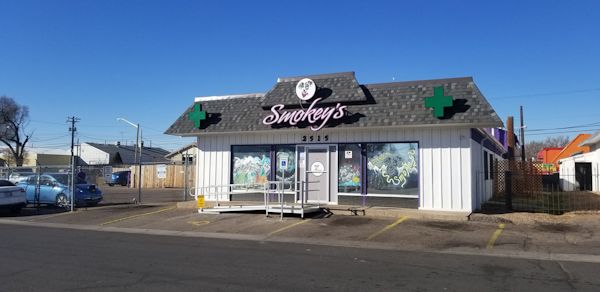SEJournal Online is the digital news magazine of the Society of Environmental Journalists. Learn more about SEJournal Online, including submission, subscription and advertising information.
 |
| Smokey’s 420 shop in Garden City, Colo., pictured above, uses soil, rather than a soilless medium, to grow its cannabis in a more sustainable manner. Photo: Smokey’s 420. Click to enlarge. |
Feature: Smokey’s 420 Gets the ‘Dirt’ on Pot Crop
By Kelsey Simpkins
Smokey’s 420 is a small, mom-and-pop shop located in the tiny township of Garden City, Colo., next to Greeley.
COO Melinda Kadinger, who joined Smokey’s 420 in 2014, the year recreational cannabis became legal in the state, said the company’s first priority was to be compliant with the rules of Colorado’s Marijuana Enforcement Division.
But within a year, Kadinger had taken on a more environmental perspective.
For instance, she didn’t like using synthetic materials to grow the plant or the amount of waste at the end of the process. So she convinced Smokey’s to take a leap of faith and grow cannabis plants in actual soil, not hydroponic foam-like cubes, or soilless medium, that is thrown out after harvest. This soil is reused and grows richer with each harvest, and provides homes to worms and a variety of helpful insects.
That transition took three to four months, and getting comfortable with the new operation took up to a year. Just five years later, in 2019, Smokey’s was recognized at the last Cannabis Sustainability Symposium for its sustainability practices.
Most growers don’t use this process because it is initially not as efficient, and the use of living soil takes know-how and investment to do it well.
“This is doable. You don't need billions of dollars to do these small little steps to be more sustainable,” said Kadinger. “But converting to living soil is jumping into the deep end and hoping you know how to swim.”
‘Under the microscope’
In many states, there is also a gray area between what is a legal and approved growing practice and what is not — and most businesses don’t want to chance being shut down over trying something new.
“You're under the microscope of the entire nation waiting for you to do something wrong,” Kadinger said.
But it ends up paying off over time, she said. These practices also lead to what Kadinger and others believe is a superior — and safer — product.
Kadinger still worries about the direction of
the larger industry’s environmental impacts,
especially the implications of federal legalization.
Her hope is that new businesses in states that have yet to legalize don’t have to go through this same experimental process to operate sustainably — and could instead learn directly from what Colorado has achieved.
Despite her award-winning efforts, Kadinger still worries about the direction of the larger industry’s environmental impacts, especially the implications of federal legalization (see related story, “Why an Unregulated Pot Business May Be Bad for the Environment”).
“It's not more expensive necessarily to be sustainable or grow in living soil, but it's not as easy,” she points out.
With millions of dollars pouring into the industry, what keeps her up at night is that states and businesses will take the easy road, and not the sustainable path.
“It could just end up being one more industry that is horrible for the environment,” she said.
Kelsey Simpkins is a writer, photographer and artist with a master’s degree in journalism. She works for the University of Colorado Boulder as a science and news writer, and media relations specialist.
* From the weekly news magazine SEJournal Online, Vol. 5, No. 18. Content from each new issue of SEJournal Online is available to the public via the SEJournal Online main page. Subscribe to the e-newsletter here. And see past issues of the SEJournal archived here.













 Advertisement
Advertisement 



